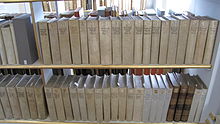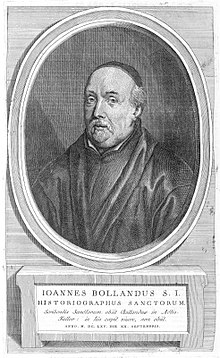Bollandists
The Society of Bollandists ( French Société des Bollandistes ) is a working group that compiles the life stories of the saints of the Roman Catholic Church in critical editions on a handwritten basis and publishes them with historical-critical commentary in the Acta Sanctorum . The name goes back to the Dutch hagiographer and theologian Johannes Bolland (1596–1665). The original goal was to protect the hagiographical tradition from general rejection by Protestantism and the rationalistic zeitgeist by means of text and tradition-critical processing .
history
In 1603 the Jesuit Heribert Rosweyde from Utrecht (1569–1629) presented the first new compilation of the holy lives for the calendar days of the whole year. Baron Heinrich Julius von Blum was one of the most energetic of the founding generation of this project, and Johann Bolland , also a Jesuit, who was born in Limburg in 1596 , later gave the group its name. In conjunction with Gottfried Henschen and Daniel Papebroch, he edited the first collection and expanded it into a company that employed a considerable number of Jesuits over the next two centuries. Bolland himself was able to present the first two volumes of the monumental work Acta Sanctorum as early as 1643 . Most of these Jesuits were Flemish and the ongoing volumes were published in Antwerp . A key sponsor of the company was Ferdinand von Fürstenberg (1626–1683), the humanistically educated secret chamberlain of Pope Alexander VII and later Prince-Bishop of Paderborn and Münster, to whom the volumes Acta SS Aprilis II from 1675 and Acta SS Maii I from 1680 were dedicated in gratitude were.
In 1788 both the Bollandists and the Jesuit order were suppressed by the government of the Austrian Netherlands , but the work was initially continued in Tongerlo , where another volume appeared (Acta SS Oct. VI 12-14, Tongerlo 1794). With the French occupation of Flanders in 1794, the work on volume 54 (ActaSS octobris VII 15-16) broke off, but was then after the founding of the Belgian state in 1837 at the instigation of the founding rector of the Catholic University of Leuven founded in 1835 , the Catholic theologian, historian and philosopher Pierre François Xavier De Ram (1804-1865), who had dealt intensively with hagiographic issues since his youth, was temporarily planned as a new employee and also the expert opinion for the Commission Royale d'Histoire of the royal, which was decisive for the continuation of the company Academy of Sciences and Fine Arts of Belgium wrote, resumed, now in Brussels , where the volumes from vol. 54 (ActaSS Octobris VII, 1845) initially with the Alphons Greuse publishing house, from vol. 57 (ActaSS Octobris X 1861) with Henri Goemare , finally published from vol. 59 (ActaSS Octobris XII 1867) by Franciscus Vromant, before from vol. 60 (ActaSS Octobris X III 1883) Victor Palmé, Paris took over until from vol. 63 (ActaSS Novembris II 1894) the Bollandists themselves operated the publishing business.

The edition project, which, with a processing period of over 300 years, is likely to be the most extensive long-term project in the history of Western science, is with 69 published volumes (including the Index hagiologicus by Rigollot, Paris 1875), which the saints from January 1st to November 10th ( ActaSS November IV, 1925) as well as the Synaxarium Ecclesiae Constantinopolitanae , the Martyrologium Hieronymianum and the Martyrologium Romanum have not yet been completed. The last volume appeared in 1925 November IV with the saints of November 9th and 10th. In the foreword, the restriction to just two days is justified by the difficult economic conditions of the post-war period and the excessively large volume of November 11th due to the extensive dossier of the texts on Saint Martin of Tours , which would have swelled the volume and continued to appear would have delayed. Contrary to the expectations aroused in the preface, however, no further volume appeared in the calendar sequence. Only two volumes with the edition of important martyrologies followed in 1931 and 1940 (see below). The appearance of further volumes is no longer to be expected, since the procedure according to calendar days, which leads to having to work on saints from different epochs and origins at the same time, has proven to be impractical. The points of view under which the edition of the hagiographic texts is now being carried out have been adapted to the current method of working in today's historical research. The edition of the saints' lives is no longer done in calendar order in the volumes of the Acta Sanctorum , but in loose succession in the Subsidia Hagiographica series or in the journal Analecta Bollandiana .
As the completion of the work became increasingly distant, attempts began to achieve completeness on a limited geographical basis. Around one hundred years after the publication of the first volume of Acta Sanctorum , Acta Sanctorum Ungariae ex Joannis Bollandi societatis Jesu Theologi, ejusque Continuatorum Operibus excerpta, et Prolegomenis ac notis illustrata by an anonymous Jesuit in Tyrnau (today Trnava ) appeared in two parts in 1743 and 1744 , the Nagyszombatie at that time. A little later, in 1750, the Benedictine Bertholdus Rizelius Mellicensis published the first and only volume of his Sancta et beata Austria, seu Acta, et vitæ sanctorum eorum, qui a primo jam inde Christi sæculo ad hanc usque ætatem cum strenue exantlatis in vinea domini laboribus, tum aliis sanctitatis suæ, dum viverent, radiis, eam, quam nunc adpellamus Austriam, regionem olim illustrarunt , who, in order to make rapid progress, renounced critical editions and instead published the vitae of the saints of the Habsburg Empire in chronological order, retold from edited sources. This was followed by the Acta Sanctorum Belgii (Brussels 1783–1794), which the Bollandist Josephus Hyppolite Ghesquiere (1731–1802) published with critical claims in six volumes. Finally, the Acta sanctorum Hiberniae ex codice Salmanticensi nunc primum integre edita opera Caroli de Smedt et Josephi de Backer e Soc. Jesu (in London / Edinburgh 1888) the Bollandists Charles de Smedt (1831–1911) and Joseph de Backer. The publication of the most important martyrologies, the Martyrologium Hieronymianum (ActaSS November II 1, 1894; II 2, 1931) and the Martyrologium Romanum (ActaSS December Propylaeum, 1940) within the volume, but outside the calendar sequence, already testifies to the endeavor in view of the Fear of no longer being able to achieve the desired goal, at least to fully grasp at least the most cultically important saints.
The Brussels-based Société des Bollandistes is the publisher of the Subsidia Hagiographica series (Volume 90 appeared in Italian in 2010), which also includes the indispensable bibliographic resources of the Bibliotheca hagiographica Latina (Subs. Hag. 6, 1898-1901; 70, 1986), the Bibliotheca hagiographica Graeca (Subs. Hag., 8a, 1957; 65, 1984), the Bibliotheca Hagiographica Orientalis (Subs. Hag. 10) and important manuscript indexes, as well as the Tabularium Hagiographicum (letter editions) and the journal Analecta Bollandiana . The electronic database Bibliotheca Hagiographica Latina manuscripta (BHLms) and the Acta Sanctorum Database , through which the monumental corpus is available online as full text, are new .
Individual evidence
- ↑ His copy of the Acta Sanctorum, which he acquired at a young age, ended up in private ownership in southern Germany via the Donaueschingen court library after it was auctioned off.
- ^ Pierre François Xavier De Ram: Les nouveaux Bollandistes. Report fait a la Commission royale d'histoire . Hayez, Brussels 1860 (also in: Bulletins de la Commission royale d'histoire, 3rd série, Vol. II 1, 1860.)
- ↑ The latest date for the start of the project is Bolland's appointment in 1630. However, it is advisable to include the preparatory work of Heribert Rosweyde, whose plan was published in 1607.
Publications of the company
- Analecta Bollandiana: revue critique d'hagiographie . Bruxelles: Société des Bollandistes 1882 (Society's Scientific Journal).
- Robert Godding, Bernard Joassart, Xavier Lequeux, François de Vriendt (eds.): De Rosweyde aux Acta Sanctorum. La recherche hagiographique des Bollandistes à travers quatre siècles. Actes du Colloque international (Bruxelles, 5 October 2007) (Subsidia Hagiographica 88). Société des Bollandistes, Brussels 2007.
- Société des Bollandistes (ed.): Christian Hagiography 1607–2007. Bollandistes, Saints et Légends. Quatre siècles de research . Société des Bollandistes, Brussels 2007.
- René Aigrain: L'hagiography. Ses sources - Ses méthodes - Son histoire. Reproduction inchangée de l'édition originale de 1953. Avec un Complément bibliographique par Robert Godding (Subsidia Hagiographica 80). Société des Bollandistes, Brussels olik.
- Paul Peeters: L'oeuvre des Bollandistes. 2nd édition augmentée d'une notice bio-bibliographique des PP. Delehaye and Peeters. Excerpt of Mémoires de l'Académie Royale de Belgique (Subsidia Hagiographica 24). Société des Bollandistes, Brussels 1961.
- Hippolyte Delehaye : L'oeuvre des Bollandistes à travers trois siècles. 1615-1915. 2e édition, avec un Guide bibliographique mis à jour (Subsidia Hagiographica 13a). Société des Bollandistes, Brussels 1959.
literature
- Andreea Badea: (Sacred) history as a dispute. The 'Acta Sanctorum' and Mabillons 'Epistola de cultu sanctorum ignotorum' and the Roman censorship. In: Thomas Wallnig, Thomas Stockinger, Ines Peper, Patrick Fiska (eds.): European cultures of history around 1700 between scholarship, politics and denomination. De Gruyter, Berlin et al. 2012, ISBN 978-3-11-025918-6 , pp. 379-404.
- Stefan Benz: Between tradition and criticism. Catholic historiography in the baroque Holy Roman Empire (= historical studies. Vol. 473). Matthiesen, Husum 2003, ISBN 3-7868-1473-2 (also: Erlangen-Nürnberg, University, dissertation, 2000).
- Bernhard Joassart: Bollandists. In: Lexicon for Theology and Church . Volume 2: Barclay to Damodos. 3rd, completely revised edition. Herder, Freiburg (Breisgau) et al. 1994, ISBN 3-451-22002-4 , Sp. 561 f.
- Pierre J. Roche: Bollandists. In: The New Catholic Encyclopedia. Volume 2: Baa to Cam. McGraw-Hill, New York NY et al. 1967, pp. 648-649.
- Jan Marco Sawilla: Antiquarianism, Hagiography and History in the 17th Century. On the work of the Bollandists. An experiment in the history of science (= early modern times. Vol. 131). Max Niemeyer, Tübingen 2009, ISBN 978-3-484-36631-2 (also: Hamburg, University, dissertation, 2008).
- Charles De Smedt: The Bollandists. In: The Catholic Encyclopedia. Volume 2: Assize - Brownr. Robert Appleton Company, New York NY 1907, pp. 630-639.

